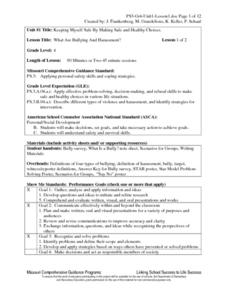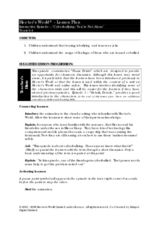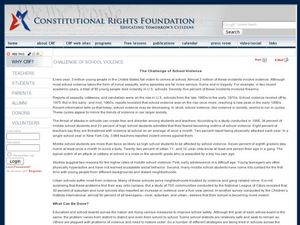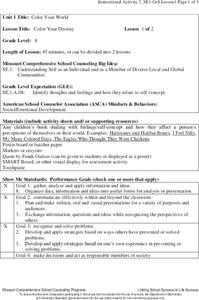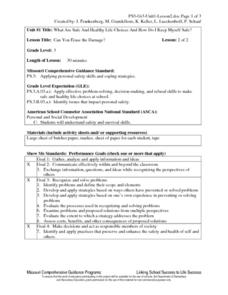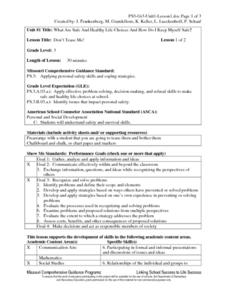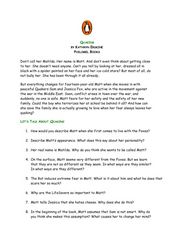Curated OER
What Are Bullying And Harassment?
Fourth graders define the four types of bullying and define harassment. They complete a True/False survey, student notes, and question and answer.
Curated OER
Dealing with Peer Influence: What Are Bullying and Harassment? Lesson 1 of 2
Fifth graders review definitions of bullying and harassment, respond to real-life bullying scenario from news, television, or movie, brainstorm possible solutions and consequences for negative behavior, and discuss how their peers...
Missouri Department of Elementary
What Are Bullying and Harassment? Part 2
After reviewing notes from the previous lessons, small groups obtain a scenario card that describes a situation in which bullying is happening. Peers discuss the event and brainstorm two solutions using the STAR method then present their...
Missouri Department of Elementary
What Are Bullying And Harassment? Part 1
A brief survey begins a lesson that challenges scholars to answer the question, What is bullying? Learners discuss their answers and take notes, paying close attention to the types of bullying and roles people play. Pupils change their...
Curated OER
Bullying
Fourth graders define the role of a bully, then participate in skits with bullying situations. For this health and safety lesson, the teacher introduces the idea of bullying with the book Enemy Pie. Then students create a double bubble...
Nemours KidsHealth
Online Safety: Grades 9-12
Teach teens how to protect themselves from hackers, scammers, and online predators. First, class members examine their own digital footprints think critically about their online profile. Groups then generate lists of "do" and "don't do"...
Missouri Department of Elementary
Don’t Tease Me!
A whole-class discussion sheds light on school bullying and ways to prevent it. Scholars share a moment when they observed or experienced some sort of teasing. Pupils brainstorm ways such behavior can be stopped or prevented.
Missouri Department of Elementary
Dealing with Peer Influence: What Are Bullying and Harassment?
Scholars examine examples of peer pressure and discuss how specific actions negatively affect one's well-being. Learners gather in small groups to write two scenarios in which peer pressure is used. They reference the STAR method in how...
Curated OER
Hector's World Cyber-bullying: You're Not Alone
Young scholars discuss cyber-bullying and how it relates to their emotional state. In this cyber-bullying lesson, students watch a short video that identifies how cyber-bullying occurs. Young scholars participate in an active...
Curated OER
Hector's World: Details, Details
Students discover what forms of personal information are alright to share online. In this Internet safety lesson, students discuss how they must be careful with personal information when they are online. Students complete a worksheet...
Facebook
Online Presence
What happens when an online post gets the wrong kind of attention? Learners evaluate the good, the bad, and the occasionally ugly side of social media posting with a instructional activity from a vast digital citizenship series. After...
Curated OER
The Challenge of School Violence
Students examine school violence. In this school violence instructional activity, students listen to a teacher-led lecture regarding statistics and studies about school violence. Students discuss ways to deter school violence and...
Childnet International
Responding to Cyberbullying
After watching a short video about cyberbullying, individuals play an online cyberbullying game and then create their own Digizen that expresses their values and presents their vision for themselves, their friends, and the world at large.
Curated OER
Can You Help A Friend?
Students take on the role of a ten year old girl, "Jessica." Jessica's friend has moved away from the area and is texting people she doesn't know in chat rooms. Students work in groups to write a message for Jessica to send to her...
Missouri Department of Elementary
Color Your Destiny
Class groups bring feeling words alive by creating a poster that illustrates with images and colors, but not words, the feeling conjured by the word. The posters are then combined into a mural for the classroom wall.
Curated OER
Can You Erase the Damage?
Third graders examine the need to treat others the way they would like to be treated. They determine whether the damage from teasing and mean words can be healed. They discuss how people feel when they are teased and how to repair the...
Curated OER
Don't Tease Me!
Third graders observe as the teacher pretends to tease a student and try to describe what the problem is. They brainstorm times when they felt unsafe at school either physically or emotionally and write down their responses on the board...
Curated OER
Cyberbullying
Students investigate internet safety by discussing harassment on the web. In this cyber safety lesson, students identify the causes and effects of cyber bullying behavior. Students discuss actions to take if they or their...
Curated OER
Risk Taking Behaviors
Tenth graders listen to a presenters introduction and write questions they hope to have answered during the presentation. They listen to a presentation and record notes. They participate in small group discussion and complete...
Curated OER
Team Building
Students participate in various activities to become more successful as a team member. In this team building lesson, students discuss team jobs versus individual ones. Students must work together to complete activities such...
Curated OER
Quaking
Students read the story Quaking by Kathryn Erskine about a girl who moves in with people who clash with her style. In this holocaust lesson plan, students also answer discussion questions.
Alabama Learning Exchange
Alex: Cybersafety
This lesson is designed to increase student awareness of the concept that there are dangers associated with Internet usage. This is a Commerce and Information Technology lesson plan. This lesson was adapted from iSafe.org and...
Common Sense Media
Common Sense Media: Education: What's Cyberbullying? Grades 3 5
Students discuss positive and negative aspects of interacting with others online. They learn the definition of cyberbullying and help the teacher fill in a Venn diagram that compares in-person bullying with cyberbullying. They then read...
